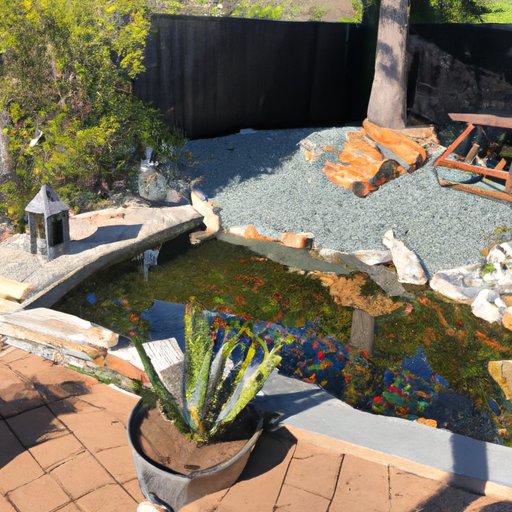
Introduction
Adding a pond to your backyard can be a beautiful and tranquil addition to your outdoor space. Not only does it create a calming oasis to enjoy, but it can also attract wildlife and add value to your home. Whether you want a small water feature or a larger pond with fish and aquatic plants, building a pond can seem daunting for beginners. In this article, we will provide a comprehensive guide to building your very own pond, from choosing the right location to seasonal maintenance.
Step-by-Step Guide
Before you begin construction, it is essential to consider several factors. The first step is to choose a suitable location. Avoid areas with overhanging trees, as debris can harm the pond’s ecosystem. Check local building codes to ensure you have the appropriate permissions to install a pond. Once you have chosen the location, the next step is to determine the pond’s size and shape. A good rule of thumb is to have a minimum depth of 24 inches to support aquatic plants and fish.
After measuring and marking the pond’s dimensions, the excavation process begins. A trench must be dug to the desired depth and shape, taking care to slope the sides gradually. A layer of sand or underlay goes over the bottom and sides, providing a cushion and preventing tears from rocks or roots.
Once the pond’s shape is complete, it is time to add the liner. PVC, EPDM, or Butyl rubber liners are popular options, depending on your budget and project specifications. The liner should be trimmed to fit and securely fixed to the sides. Next, install the pond’s filtration system, which is vital for maintaining clean water.
After setting up the filtration system, it is time to start the pond’s landscaping. Choose aquatic plans and water lilies that are suitable for your pond’s depth and sun exposure. Add a few fish to enhance the pond’s natural ecosystem, and keep in mind that proper feeding and care of the fish are required.
Budget-Friendly Options
Building a pond can be expensive, but there are ways to save money. For example, recycled materials such as old bathtubs or containers can be repurposed. Prefabricated pond kits are another budget-friendly option that provides all the necessary equipment and instructions for a stress-free assembly.
When building a pond on a budget, consider using a smaller size and avoiding extensive hardscaping. Although rocks and boulders can create a natural look, they can be costly. Consider purchasing basic equipment, such as a pump and filtration system, second-hand.
Creative Pond Design
Building your pond offers many opportunities to flex your creative muscle. Try using shapes other than the standard rectangle or circle. Incorporate waterfalls or streams into your design to add a calming sound and motion to the water. Landscaping around the pond and adding stepping stones can blend the pond beautifully with the surrounding environment.
To create visual interest, vary the depth of different areas in the pond. Consider using native stones or other materials to build a raised edge around the waterline. Achieving a natural look is essential, so take care to maintain appropriate proportions and blend with the existing landscape.
DIY Mistakes to Avoid
While building your pond can be a rewarding endeavor, several common mistakes can occur. Understanding these common pitfalls will help you avoid costly repairs or complete pond failure. Poor pond placement, inadequate filtration, and incorrect liner installation are the most common causes of pond failures.
It is essential to have a plan in place before starting construction and to understand your pond’s unique requirements, such as sun exposure and required depth. Failing to research the necessary equipment and spending too little on materials and hardware can lead to problems. Ask for help and advice from a pond professional if you feel unsure about any aspect of the build process.
Seasonal Maintenance
A pond requires ongoing maintenance throughout the year to ensure a healthy environment for plants and fish. Regular cleaning and maintaining balanced water chemistry are crucial to keeping the pond healthy and sustainable. During the fall, remove debris and fallen leaves from the surface and bottom of the pond. Ice can harm the fish if the pond freezes over, so consider investing in a pond deicer to prevent ice build-up.
During the spring, prepare the pond for the upcoming growing season. Test the water balanced and pH levels, and adjust if necessary. Remove any chlorine or chemicals used during pond cleaning before planting new foliage or adding fish. Summer is the peak growth and maintenance season for your pond. Remove any dead foliage and algae as required to keep the pond clean and fresh.
Benefits of Having a Pond
A backyard pond adds value to the outdoor living space and creates a sense of tranquility. Water features such as ponds are known stress relievers and add to the ambiance of the outdoor environment. Ponds also attract birds, frogs, insects, and beneficial creatures, adding to the natural beauty of the garden.
Having a pond means watching it mature over time, providing a sense of satisfaction and pride that comes from building and maintaining a beautiful and functional water feature.
Conclusion
Building a pond requires careful planning and execution, but the results are worth it. From choosing the right dimensions and location to selecting fish and plants, there are many factors to consider. But with proper care and maintenance, a pond can enhance the beauty of your outdoor space and provide a place of peace and tranquility.
We hope this comprehensive guide has given you helpful tips and insights into building your own pond. Remember to research and prepare before starting construction and to seek professional advice when necessary. With a little creativity and determination, you can create a beautiful pond that you can enjoy for years to come.





